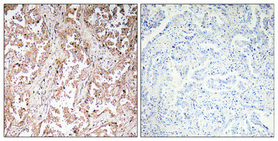UCP2 Polyclonal Antibody
- 产品详情
- 实验流程
- 背景知识
Application
| IHC-P |
|---|---|
| Primary Accession | P55851 |
| Reactivity | Human, Mouse, Rat |
| Host | Rabbit |
| Clonality | Polyclonal |
| Calculated MW | 33229 Da |
| Gene ID | 7351 |
|---|---|
| Other Names | UCP2; SLC25A8; Mitochondrial uncoupling protein 2; UCP 2; Solute carrier family 25 member 8; UCPH |
| Dilution | IHC-P~~Immunohistochemistry: 1/100 - 1/300. ELISA: 1/10000. Not yet tested in other applications. |
| Format | Liquid in PBS containing 50% glycerol, 0.5% BSA and 0.09% (W/V) sodium azide. |
| Storage Conditions | -20℃ |
| Name | UCP2 |
|---|---|
| Synonyms | SLC25A8 {ECO:0000303|PubMed:33798544} |
| Function | Antiporter that exports dicarboxylate intermediates of the Krebs cycle in exchange for phosphate plus a proton across the inner membrane of mitochondria, a process driven by mitochondrial motive force with an overall impact on glycolysis, glutaminolysis and glutathione-dependent redox balance. Continuous export of oxaloacetate and related four-carbon dicarboxylates from mitochondrial matrix into the cytosol negatively regulates the oxidation of acetyl-CoA substrates via the Krebs cycle, lowering the ATP/ADP ratio and reactive oxygen species (ROS) production (PubMed:24395786). May mediate inducible proton entry into the mitochondrial matrix affecting ATP turnover as a protection mechanism against oxidative stress. The proton currents are most likely associated with fatty acid flipping across the inner membrane of mitochondria in a metabolic process regulated by free fatty acids and purine nucleotides (By similarity) (PubMed:11171965, PubMed:11278935, PubMed:22524567, PubMed:26182433, PubMed:33373220). Regulates the use of glucose as a source of energy. Required for glucose-induced DRP1-dependent mitochondrial fission and neuron activation in the ventromedial nucleus of the hypothalamus (VMH). This mitochondrial adaptation mechanism modulates the VMH pool of glucose- excited neurons with an impact on systemic glucose homeostasis (By similarity). Regulates ROS levels and metabolic reprogramming of macrophages during the resolution phase of inflammation. Attenuates ROS production in response to IL33 to preserve the integrity of the Krebs cycle required for persistent production of itaconate and subsequent GATA3-dependent differentiation of inflammation-resolving alternatively activated macrophages (By similarity). Can unidirectionally transport anions including L-malate, L-aspartate, phosphate and chloride ions (PubMed:22524567, PubMed:24395786, PubMed:26182433). Does not mediate adaptive thermogenesis (By similarity). |
| Cellular Location | Mitochondrion inner membrane {ECO:0000250|UniProtKB:P70406}; Multi-pass membrane protein |
| Tissue Location | Widely expressed in adult human tissues, including tissues rich in macrophages. Most expressed in white adipose tissue and skeletal muscle. |
Research Areas
For Research Use Only. Not For Use In Diagnostic Procedures.
Application Protocols
Provided below are standard protocols that you may find useful for product applications.
BACKGROUND
UCP are mitochondrial transporter proteins that create proton leaks across the inner mitochondrial membrane, thus uncoupling oxidative phosphorylation from ATP synthesis. As a result, energy is dissipated in the form of heat.
终于等到您。ABCEPTA(百远生物)抗体产品。
点击下方“我要评价 ”按钮提交您的反馈信息,您的反馈和评价是我们最宝贵的财富之一,
我们将在1-3个工作日内处理您的反馈信息。
如有疑问,联系:0512-88856768 tech-china@abcepta.com.
¥ 1,500.00
Cat# AP72996























 癌症的基本特征包括细胞增殖、血管生成、迁移、凋亡逃避机制和细胞永生等。找到癌症发生过程中这些通路的关键标记物和对应的抗体用于检测至关重要。
癌症的基本特征包括细胞增殖、血管生成、迁移、凋亡逃避机制和细胞永生等。找到癌症发生过程中这些通路的关键标记物和对应的抗体用于检测至关重要。 为您推荐一个泛素化位点预测神器——泛素化分析工具,可以为您的蛋白的泛素化位点作出预测和评分。
为您推荐一个泛素化位点预测神器——泛素化分析工具,可以为您的蛋白的泛素化位点作出预测和评分。 细胞自噬受体图形绘图工具为你的蛋白的细胞受体结合位点作出预测和评分,识别结合到自噬通路中的蛋白是非常重要的,便于让我们理解自噬在正常生理、病理过程中的作用,如发育、细胞分化、神经退化性疾病、压力条件下、感染和癌症。
细胞自噬受体图形绘图工具为你的蛋白的细胞受体结合位点作出预测和评分,识别结合到自噬通路中的蛋白是非常重要的,便于让我们理解自噬在正常生理、病理过程中的作用,如发育、细胞分化、神经退化性疾病、压力条件下、感染和癌症。






